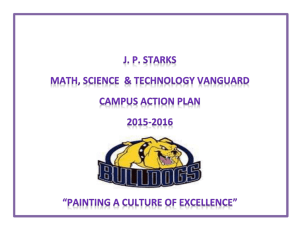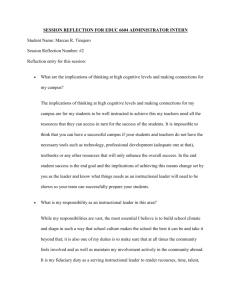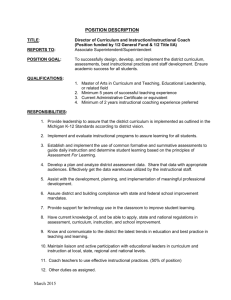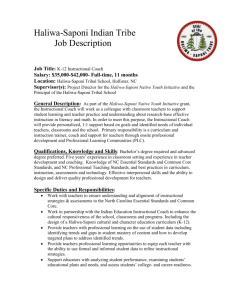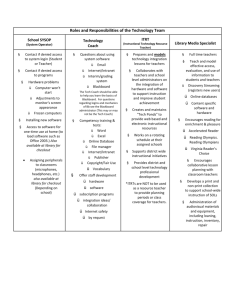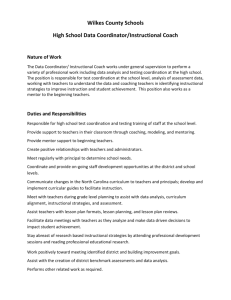J. P. Starks Math, Science & Technology Vanguard Campus Action
advertisement
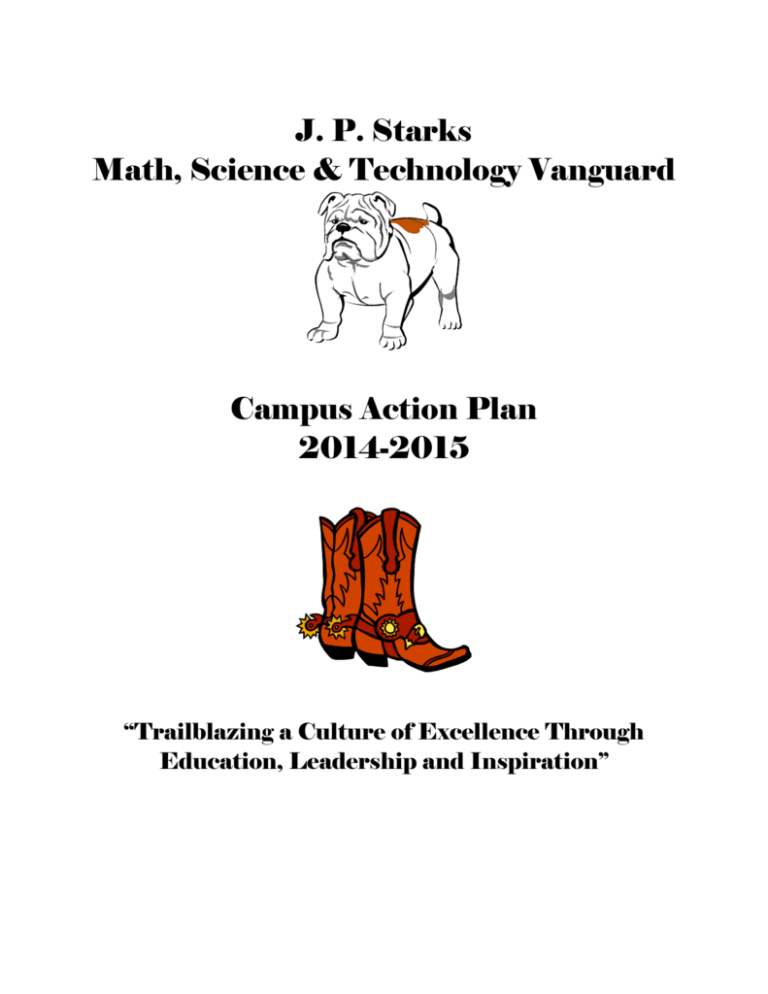
J. P. Starks Math, Science & Technology Vanguard Campus Action Plan 2014-2015 “Trailblazing a Culture of Excellence Through Education, Leadership and Inspiration” JPS MST Achievement Targets Metric SY2014 Score SY2015 Goal Percentage of STAAR tests at Level 3* 14.9 50% Elementary (K-5) Gap between minority students' STAAR performance and state's white students, based on percentage of tests at Level 2 (recommended standard)† AA: 29.6 AA:15% H: 3.9 H: 2.0% 56 66% Percentage of Grade 4 writing STAAR tests at Level 2 (recommended standard)* 88.2 95% Percentage of all ACP exams passed* 72.4 82% Percentage of Grade 3 reading STAAR tests at Level 2 (recommended standard)* Needs Assessment Needs Related to Student Achievement Data: J. P. Starks will focus on aligning our campus mission with the district's core beliefs. Although, the STAAR achievement data shows J. P. Starks performed above the district's passing percentage in almost call categories, there was a decrease in the overall average for fifth grade science.. Starks STAAR 2014/15: 3 4 5 (3-5) READING 56% 67% 84% 74% MATH 50% 64% 83% 67% SCIENCE N/A N/A 86% 76 WRITING N/A 88% N/A 88% Needs Related to Improving the Quality of Instruction: Professional Development: Provide staff development training in curriculum alignment, content specific strategies, planning good first instruction, DOLs, MRS strategies, technology integration, common assessments, disaggregating data, cultural awareness, discipline management, and character development. Supplies and Materials: Educational Supplies: bulletin board paper, laminating machine, laminating paper, border, die cutter, die cutter supplies, dry erase boards, dry erase markers, visa pens, ink pens, notebook paper, construction paper, tag board, overhead projectors and bulbs, transparencies, transparency maker, sentence strips, pocket charts, stapler, staples, paper clips, pencils, pencil sharpeners, Ziploc bags, erasers, hole puncher, folders, binders, binding combs, headphones, desktop carrols, batteries, scissors, copier, copier toner, copier cartridges, maintenance contract for copiers, copying paper, poster making paper, poster making machine, snacks for Saturday School, chart paper, gardening tools/equipment, educational workbooks, journals, manipulatives, leveled readers, science equipment, art supplies, music supplies, physical education supplies, student intervention material, incentives, awards, field trips, bus fees, entrée fees, breakfast/lunch items; Technology Supplies: computers, computer supplies, printers, printer ink, computer tables, surge protectors, site licenses, software, hardware, overhead projectors and bulbs, transparencies, transparency machine, tape recorders, CD players, CD’s, SmartBoard, Smartboard software and supplies, document cameras, digital cameras, Automatic Response ,math, science and technologys, airliners, slates, Ipads, Ipods, E-Readers, Infocus machines, Infocus bulbs, copier, copier toner, copier cartridges, maintenance contract for copiers, copying paper, poster making machine and paper, netbooks, scantron machine and paper; Tutorial supplies: books, materials, extra duty pay for afterschool and extended day, snacks, games; Professional Development: Master Teacher PD program, research based books for book studies, workshops, state/regional/local conference fees, training materials and supplies, consultants, staff retreat; Parental Involvement: training materials, make/take supplies, refreshments, incentives, awards, and supplies for parent center; Student Achievement: trophies, awards, certificates, medals. Needs Related to Symath, science and technology Evaluation (philosophy, processes, implementation, capacity): Philosophy: Embed the core beliefs in math, science and technology throughout the school's organization. Utilize a data room for training, reflection and data disaggregation. Processes: Training for targeted objectives and research based strategies that promote rigor and good first instruction. Improve parent support in math, science and technology through trainings and consistent communication. Funds will be needed for stipends, reimbursement fees, travel fees, extra duty pay, resources, consultant fees, materials, technology, incentives, and field trips. Implementation: Differentiated and small group instruction. Assessment planning through RTI interventions, Reasoning Mind, ISIP, Interims and ACP’s. Capacity: Hire highly qualified teachers to ensure success of all students. Build Leadership Capacity and Coalitions through PLC's with a commitment to the pursuit of excellence and avoid EXCUSES for poor instruction and effort. Goals Developed from Needs Assessment: Based on the needs of our students we have created goals focused on the following three areas: Culture of Excellence, Good First Instruction, and Strategic Recruitment for STEM. All goals are written toward the ultimate goal of Student Achievement. We welcome all stakeholders; parents/guardians, business partners, community members, and institutions of higher learning to assist us in our efforts to provide an outstanding learning experience for all students. Improve feedback and coaching. Improve school culture and climate. Improve MATH, SCIENCE AND TECHNOLOGY instruction through leadership capacity. Key Action 1: NO. 1 NO. 1 2 3 Culture of Excellence KEY ACTION (Briefly state the specific goal or objective.) Establish an active professional learning community that utilizes 21st Century skills and the best research/evidence based practices and on-going professional development on the implementation of Core Beliefs and its philosophy, strategies to increase parental engagement and utilization of Campus Discipline Management Plan to maintain a safe, secure and orderly environment to challenge, inspire, and engage all learners. INDICATORS OF SUCCESS (Measurable results that describe success.) Each teacher will submit a self-reflection evaluation to determine whether individual and grade level goals were met at the end of the year. 100% of the staff will know create, understand and implement the Campus Discipline Management Plan in an effort to create positive culture and environment from 57.7% to 80 %. 100% of teachers will ensure Parental Engagement through Parent Academies (PAWS Happy Hour) Thursday Communication Folder and Parental Contact Logs. SCHOOL LEADERSHIP ACTIONS (What specific action steps will the building leaders take to accomplish the objective?) A1 Administrator, Instructional Coach and ILT will conduct professional development on Core Beliefs, School Action Plan, SMART goals for SLO's, and Campus Discipline Management Plant during weekly PLC's, grade level meetings and vertical meetings. B1 Administration, ILT, Instructional Coach, SCRUB team will provide professional development opportunities to introduce, review and monitor Campus Discipline Management Plan (CHAMPs), which will decrease discipline referrals by 10%. C1 Administration will increase parental engagement 15% by providing opportunities for promoting parent engagement through Thursday contact folders, newsletters, incentives, campus website, copying supplies, PAWS and communication logs STAFF ACTIONS (What specific action steps will the staff take to accomplish the objective?) A2 During PLC's staff will participate and implement professional development best practices, core beliefs philosophy, SMART goals and strategies for maintaining a safe, secure and orderly environment. B2 Teachers will participate in Campus Discipline Management Plan Professional Development and implement strategies to decrease discipline referrals and incident reports by 10%. C2 Each grade level will plan and provide 1 parent academy (PAWS Happy Hour) each semester in order to increase parent engagement by 15% and provide instructional strategies to assist with student achievement. Key Action 2: NO. 2 NO. 1 Good First Instruction KEY ACTION (Briefly state the specific goal or objective.) J. P. Starks will provide good first instruction of the District curriculum to ensure academic mastery and college and career readiness and increase student achievement by maximizing the use of assessments by analyzing, interpreting and sharing assessment data to guide and inform instructional decisions. INDICATORS OF SUCCESS (Measurable results that describe success.) 90% of teachers will receive an average of 2.0 or higher on the indicator for "use variety of instructional strategies to engage students" and "multiple response strategies" as measured by administration with the use of the SPOT observation form by April 2015 with feedback provided during conferences. STAAR scores in reading, writing, math and science in the general education population will show a 25% increase. Vanguard population will show a 15% increase. 80% of K-2 students will score at or above the 40% percentile on the ITBS math and reading assessment. All ACP tested areas will show an increase of 24%. Each classroom will be equipped with a highly qualified teacher. 2 3 SCHOOL LEADERSHIP ACTIONS (What specific action steps will the building leaders take to accomplish the objective?) A1 Administration, Instructional Coach and ILT will monitor the use of curriculum maps, lesson plans, MRS, SLO's and provide feedback through conferences with the use of technology. B1 Administrator will monitor progress of all students with a focus on Tier 3 students though data analysis (STAAR, Web-based programs, technology,SchoolNet, Common Assessments and ACP's). C1 Administrator, Instructional Coach, and ILT will participate in local, district, and national conferences and Master Teacher PD program to keep abreast of best instructional practices and strategies that will serve as the catalyst in providing ongoing professional development for teachers during Mastery Mondays. STAFF ACTIONS (What specific action steps will the staff take to accomplish the objective?) A2 Teachers will submit and create lesson plans and utilize technology aligned to District Curriculum maps and engage students through professional development strategies, MRS, Check for Understanding, Bell to Bell instruction at a proficient level to ensure Good First Instruction. B2 Teachers will participate in Campus Discipline Management Plan Professional Development and implement strategies to decrease discipline referrals and incident reports by 10%. C2 Teachers will attend campus, feeder pattern, district, regional, state, national, and Master Teacher PD Program in an effort to ensure good first instruction. Key Action 3: NO. 3 NO. 1 2 3 Strategic Recruitment KEY ACTION (Briefly state the specific goal or objective.) J. P. Starks will increase and sustain student interest in math, science and technology through STEM activities and a targeted recruitment plan for Vanguard. INDICATORS OF SUCCESS (Measurable results that describe success.) Increase the number of students achieving successfully in math, science, technology and participating in cocurricular programs (Sisters in Science, Gaming Gurus, Number Ninjas Math Club, Can You Dig It? Garden Club) by 10% through the use of investigations, labs, project based learning and informal educational opportunities beyond conventional instruction. Increase parental engagement in the area of math, science and technology. All MATH, SCIENCE AND TECHNOLOGY teachers will receive an additional 14 hours of professional development of MATH, SCIENCE AND TECHNOLOGY focused content and pedagogical strategies. SCHOOL LEADERSHIP ACTIONS (What specific action steps will the building leaders take to accomplish the objective?) A1 Administrator will provide resources, monitor lessons, labs, and project based activities to ensure the highest level of student engagement, as well as monitor progress of co-curricular programs to increase vanguard population. B1 Administrator will promote vanguard program by scheduling parental engagement activities that are math, science and technology based. C1 Administrator will provide resources and or plan additional professional development for all MATH, SCIENCE AND TECHNOLOGY teachers to ensure additional 14 hours are met. STAFF ACTIONS (What specific action steps will the staff take to accomplish the objective?) A2 Teachers will ensure that 95% of students are actively engaged through rigorous lessons, lab investigations, project based learning and other activities that extend learning beyond the classroom. B2 Teachers will participate in Campus Discipline Management Plan Professional Development and implement strategies to decrease discipline referrals and incident reports by 10%. C2 Teachers will attend additional 14 hours of professional development in MATH, SCIENCE AND TECHNOLOGY related content areas to ensure student engagement and academic mastery. JPS MST Professional Development Calendar 2014-2015 DATE TOPIC Presenter 8/15/2014 New Teacher Orientation 8/18/2014 Campus Preparation Team Building Region 10 Effective Diff. Instruction Curriculum Alignment Data-Drive Instruction Campus Preparation Core Beliefs CDMP SLO’s DISD Convocation Region 10 : New TEKS Campus Writing Plan First Day Procedures Concerns/Issues CDMP Revisited Project Based Learning Science Safety Science Labs Exceeds Data Driven Instruction Vision Boards Habits of Effective Transitions Great Habits/Great Minds Writing Plan Steaming with STEMS Principal ILT Instructional Coach Principal PreK-5 Teachers Principal PreK-5 Teachers Superintendent Principal Region 10 Instructional Coach Principal Computer Tech PreK-5 Teachers ILT Science ILT PreK-5 Teachers Counselor Instructional Coach Principal PreK-5 Teachers Principal PreK-5 Teachers Instructional Coach ILT New Teachers STEM Teachers Counselor PreK-5 Teachers 8/19/2014 8/20/2014 8/21/2014 9/1/2014 9/8/2014 9/15/2014 9/19/2014 9/22/2014 SST Bullying Awareness Compliance Videos Identified Audience New Teachers PreK-5 Teachers RESULTS 10/6/2014 10/13/2014 10/20/2014 10/27/2014 11/3/2014 11/10/2014 11/17/2014 11/24/2014 12/1/2014 12/8/2014 12/15/2014 1/12/2015 1/26/2015 2/2/2015 2/9/2015 2/16/2015 Interim Assessment Data Analysis STAR Chart ACP Writing Math Prob. Sol. RM Updates Balanced Literacy Star Chart Analyzing Personal Narrative Writing Scoring Rubric SST Interim Assessment Data Profiling Student Data Interim Assessment Data Analysis Region 10: Teaching Science through Literature Figure 19: Critical Thinking Process Skills Cross Content K-5 ACP Testing Blueprint Review Differentiated Instruction ACP Testing Procedures/Schedule First Semester Wrap-Up SMART Goal Reflection District/Feeder Comparison Data Math Technology Writing Plan Review Climate Survey Campus Review Value of Parental Engagement Assessments Principals of Great Teaching Website Potluck Principal Instructional Coach PreK-5 Teachers Campus Tech Instructional Coach 3-5 Teachers Campus Technologist Instructional Coach Counselor PreK-5 Teachers Writing Teachers PreK-5 Teachers Principal Instructional Coach PreK-5 Teachers Instructional Coach PreK-5 Teachers Region 10 PreK-5 Teachers Principal PreK-5 Teachers Counselor PreK-5 Teachers Counselor PreK-5 Teachers Instructional Coach ILT PreK-5 Teachers Principal PreK-5 Teachers Math ILT Instructional Tech Math Teachers Writing Teachers Principal Principal Counselor PreK-5 Teachers PreK-5 Teachers Principal Campus Tech Coach Berg PreK-5 Teachers Staying in Shape 2/23/2015 Close Reading: Analyzing the Complexity of a Text Instructional Coach ELAR Teachers 3/23/2015 STAAR Procedures Istation Updates Test Taking Strategies ITBS Testing Procedures Relevance & Rigor ACP Written Composition Rubric and Strategies Steaming with STEMS SSI Earth Day TEI Survey ACP Writing STEAMING with STEMS ACP/STAAR Testing Procedures Climate Survey End of Year Evaluation Goal Setting 2015/2016 Counselor Instructional Coach PreK-5 Teachers Counselor Instructional Coach PreK-5 Teachers Instructional Coach Science ILT Writing Teachers Science/Math Teachers Principal/Counselor Science ILT Principal Instructional Coach ILT Counselor PreK-5 Teachers Principal PreK-5 Teachers 4/6/2015 4/13/2015 4/20/2015 4/27/2015 5/12/2015 5/27/2015 PreK-5 Teachers PreK-5 Teachers
